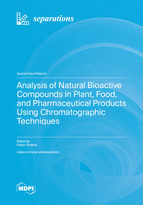Analysis of Natural Bioactive Compounds in Plant, Food, and Pharmaceutical Products Using Chromatographic Techniques
A special issue of Separations (ISSN 2297-8739). This special issue belongs to the section "Analysis of Natural Products and Pharmaceuticals".
Deadline for manuscript submissions: closed (31 May 2023) | Viewed by 17153
Special Issue Editor
Interests: HPTLC; HPLC, nanotechnology; GC-MS; pharmaceutical analysis; phytochemical analysis
Special Issues, Collections and Topics in MDPI journals
Special Issue Information
Dear Colleagues,
A growing tendency toward the discovery and use of natural bioactive compounds that are the least harmful, have the fewest side effects, and fit the human body the most naturally has been seen over the past few decades. As evidenced by the rise in recent studies on the therapeutic properties of plants, this trend has caused a return of healthcare professionals to nature and plants, but with a modern approach that specifically questions how plants help to heal humans and what their exact effects on the human body are. The medicinal properties of plants are related to their phytochemical makeup, which is a complex matrix with a large number of naturally occurring bioactive molecules that must be distinguished in order to be identified. The separation of natural bioactive chemicals from plants can be accomplished utilizing cutting-edge, high-tech, hyphenated chromatographic approaches, which also give us a ton of information to be able to identify compounds. In order to explain a plant's mechanism of action and therapeutic effect, modern healthcare providers need to be able to link the phytochemical profile of a plant employed in therapy to a biological activity. In addition to plants, natural bioactive substances can be found in a variety of foods and pharmaceuticals. As a result, it is crucial to analyze these chemicals in plant, food, and pharmaceutical products. In order to identify and analyze natural bioactive compounds in plant, food, and pharmaceutical products, this Special Issue attempts to compile the latest improvements, advancements, and analytical innovations in chromatographic techniques. Additionally, we seek to enable researchers to link the phytochemical profiles of plants, foods, and pharmaceuticals with proven therapeutic effects, which may later substantiate the health-related claims made for these products.
Dr. Faiyaz Shakeel
Guest Editor
Manuscript Submission Information
Manuscripts should be submitted online at www.mdpi.com by registering and logging in to this website. Once you are registered, click here to go to the submission form. Manuscripts can be submitted until the deadline. All submissions that pass pre-check are peer-reviewed. Accepted papers will be published continuously in the journal (as soon as accepted) and will be listed together on the special issue website. Research articles, review articles as well as short communications are invited. For planned papers, a title and short abstract (about 100 words) can be sent to the Editorial Office for announcement on this website.
Submitted manuscripts should not have been published previously, nor be under consideration for publication elsewhere (except conference proceedings papers). All manuscripts are thoroughly refereed through a single-blind peer-review process. A guide for authors and other relevant information for submission of manuscripts is available on the Instructions for Authors page. Separations is an international peer-reviewed open access monthly journal published by MDPI.
Please visit the Instructions for Authors page before submitting a manuscript. The Article Processing Charge (APC) for publication in this open access journal is 2600 CHF (Swiss Francs). Submitted papers should be well formatted and use good English. Authors may use MDPI's English editing service prior to publication or during author revisions.
Keywords
- phytochemical analysis
- food composition analysis
- pharmaceutical analysis
- gas chromatography mass spectrometry
- liquid chromatography mass spectrometry
- high-performance thin-layer chromatography
- high-performance liquid chromatography
- ultra-high performance liquid chromatography
- supercritical fluid chromatography






